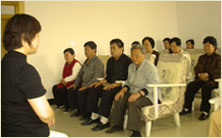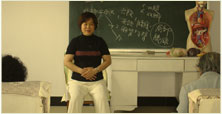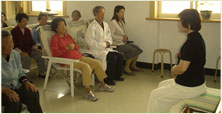Welcome to website of Nei Yang Gong and Tai Ji Quan

The quiet and meditative element of Nei Yang Gong Qigong practice, known as
Jìng Gōng 静功 (Quiet work) is a method of achieving a relaxed Qigong state and of directing the flow of energy around the body.
The Nei Yang Gong Jing Gong Exercises are a generally static quiet and relaxing mental practice using breath control, focusing on Qì 气 (pronounced ‘Chee’) and on directing energy, additional breathing techniques, balancing the body, and achieving a peaceful and harmonious practice
Where required the hands can be moved to help guide the movement of Qì 气 (energy)
The are many variations of exercise position, breathing methods and mental exercises as follows;
The Jìng Gōng 静功practice involves a range of exercises, positions and methods of breathing, each which has its own specific benefits.
At the Foundation level Chū Jí 初级 the initial method of Jing Gong practice is the
Sōng Jìng Zhū Jí Fă 松静筑基法 (relax quiet build strength method).
This method is a simple meditational exercise aimed at developing the ability to relax the body and quiet the mind by focusing on the word Jìng 静 (Quiet/Calm) when breathing in and on the word Sōng松 (relax) when breathing out.
This method can be practiced in any of the three Jìng Gōng 静功postures; Standing, Sitting or Lying as described in detail later in this section. Breathing can be through the nose, or if more comfortable in through the nose and out through the mouth, and should be as relaxed and soft as possible.
At the Intermediate level a number of additional Jìng Gōng 静功methods of exercise are introduced including additional positions and breathing methods.
The Five Jìng Gōng 静功methods can be practiced in one of two ways;
Part by Part Practice
This method of practice involves separating the body into five regions;
The Head and Neck
The Upper Torso (Chest, upper back and shoulders)
The Lower Torso (Abdomen, waist, hips, buttocks and lower back)
The Arms (Arms, elbows, wrist and hands)
The Legs (Thighs, knees and lower leg)
The Feet (Ankles, feet and toes

Where required this practice can also be narrowed down to focus on a particular organ or specific part of the body.
Whole Body Practice
This method works the body as single entity
In the early stages it is best to use the Part by Part method to develop ones ability before moving on the more effective Whole Body practice.
The Whole body method can also be used at any stage when time is limited.
Just as with the Part by Part practice the Whole Body practice involves focusing on energy moving in a specific way within the body combined with the breath, focusing on the word
Jìng 静 (Quiet/Calm) when breathing In and on the word Sōng松 (relax) when breathing out.
It can be practiced in each of the three basic positions as well as the four additional positions included at the intermediate level.
At the Chū Jí 初级 (Foundation level) when practising the Sōng Jìng Zhū Jí Fă 松静筑基法
(relax quiet build strength method) there is no need to focus on the breathing, simply breathing naturally.
At the Zhōng Jí 中级 (Intermediate level) the breathing should be smooth, relaxed, soft and flowing, often with natural slight abdomen raise, but not holding the breath.
Smooth relaxed breathing opens up energy pathways and promotes circulation of Qi and blood.
At more advanced levels of practice the Soft and Hard methods of breathing may be used as appropriate when practicing the additional Jing Gong exercises mentioned later.
Glossary of terms
法Fă Method
合Hé Close
横Héng Horizontal
降Jìang Descend
静Jìng Quiet
聚Jù Gather
开Kāi Open
散Sàn Separate
升Shēng Ascend
松Sōng Relax
气Qì Life force energy
向Xiàng Direction
血Xuě Blood
意Yì Mind
整体Zhěng Tǐ Whole body
纵Zòng Vertical


Part by Part Practice (Exercises 1 – 5)
At the early stage of practice the Jing Gong exercises involve natural continuous breathing.
The ‘movement’ of energy should be aligned with the breathing, beginning and ending simultaneously. Each region of the body should be focused on for at least six full cycles of breath in the order listed above.
For specific remedial purposes it is possible to focus on smaller areas such as specific joints, muscles, organs or other soft tissue. This process can enhance the flow of energy (and blood) to these areas and have a healing and nourishing effect. It is important to maintain a relaxed awareness of the part of the body that you are focusing on rather than exert any mental effort or force. Such focus on a specific body part can lead to an excessive build up of Qi and/or
Qi stagnation.
At the end of the first full exercise cycle the focus should be gently shifted to the Dān Tián丹田
(a point roughly 2 inches below the navel in the very centre of your body) for 3 - 5 minutes, followed by a 2nd and 3rd cycle, each followed by gently focusing on the Dān Tián丹田for 3 - 5 minutes.
If the practice is interrupted then focus on the Dān Tián丹田for 3 – 5 minutes before resuming.
One full cycle of all Six body regions should take 15 minutes.
It is important to bring the practice to a gradual completion, slowly becoming aware of the surroundings. If practicing in a lying or seated position care should be taken on rising.
At the end of the practice it is advisable to practice a short series of ‘cool down’ exercises listed at the end of this page. It is advisable therefore to practice where possible in an environment where you are unlikely to be disturbed. It is however possible to practice the Jìng Gōng 静功 (Quiet work) method in a range of environments such when stuck waiting, travelling or in any potential stressful situation as the benefits far outweigh any likely disturbance.
If the practice is interrupted or disturbed simply re-focus on your breathing and then you centre to return to a relaxed state before continuing the practice.
If at any stage you feel dizzy, light headed, uncomfortable in any way the sit in a comfortable chair and simply practice the Sōng Jìng Fă 松静法(Relax Quiet Method) exercise simply focusing on the word Jìng 静 (Quiet/Calm) when breathing in and on the word Sōng松 (relax) when breathing out allowing the body to relax and the mind and energy to settle.
The Jìng Gōng 静功 (Quiet work) Exercises
Part by Part practice
1. 纵向开降松静法
Zòng Xiàng Kāi Jìang Sōng Jìng Fă
Vertical direction Open Descend relax quiet method
You should imagine the area of the body being focused on growing like a huge mountain, connecting to nature, the earth and the sky or heavens.
On breathing In imagine energy growing from the centre line of the region of the body being focused flowing out to connect with nature as it expands opens thinking of the word
Jìng 静 (Quiet/Calm).
On the Out breath imagine the energy in the region or part of the body being focused on sinking or descending from top to bottom thinking of the word Sōng松 (relax)
Effective for: learning to relax, hypertension, stress, poor circulation, balancing Yin and Yang
2. 纵向升降松静法
Zòng Xiàng Shēng Jìang Sōng Jìng Fă
Vertical direction Ascend Descend relax quiet method
Imagine Qì 气 (energy) rising on each In breath from the very bottom to the top of region of the body being focused on, thinking of the word Jìng 静 (Quiet/Calm), and then sinking back down on the Out breath, like a cup filling and then emptying with liquid, thinking of the word
松Sōng (Relax). Feel the Qì 气 (energy) cascading from top to bottom like a waterfall.
Effective for: deficiency problems, insomnia, poor circulation, low blood pressure
3. 纵向聚降松静法
Zòng Xiàng Jù Jìang Sōng Jìng Fă
Vertical direction Gather Descend relax quiet method
On breathing In imagine you are gathering in Qì 气from the outside (surrounding nature, the sun, the moon, the stars, the ocean, the blue sky, or forests, woodlands or plants) into the centre line of the region of the body being focused on, thinking of the word Jìng 静 (Quiet/Calm).
Imagine the centre line of the body acting like a magnet to Qì 气
On breathing Out and thinking of the word松Sōng (Relax) feel the sensation of relaxing down to bottom of region of t Qì 气body being focused on like a waterfall of energy or a cup or glass emptying and the Qì 气 (energy) sinking or descending from top to bottom.
Effective for: Toning and cleansing, liver and kidneys and smoothing the circulation of Qì 气 in the meridians. It can also be useful for mixed symptoms and digestive disorders.
4. 横向开合松静法
Héng Xiàng Kāi Hé Sōng Jìng Fă
Horizontal direction Open Close relax quiet method
On breathing In imagine energy flowing into the region or part of the body being focused on and imagine and feel it expanding and growing, opening out from the centre line, thinking of the word Jìng 静 (Quiet/Calm).
On breathing Out imagine energy flowing back into the centre line of the of the region of the body being focused on and it closing or contracting, thinking of the word松Sōng (Relax)
Effective for: Nourishing Yang Qi, Opens Qì 气pathways, problems caused by Stagnation of Qì 气, strengthening the functions of the organs and the digestive system. Opens meridians and increases flow of blood.
5. 横向聚散松静法
Héng Xiàng Jù Sàn Sōng Jìng Fă
Horizontal direction Gather Separate relax quiet method
On Breathing In imagine gathering energy from the edge of the universe to the centre line of the region or part of the body being focused on, thinking of the word静Jìng (quiet) and feeling your mind becoming calm and quiet.
On breathing Out imagine separating out any negative Qì 气(emotions, discomfort or disease) from the centre line of the part of the body being focused on and sending them floating far away from the body out to the edge of the universe. Feel the region of the body relaxing from the centre line outwards thinking of the word松Sōng (relax)
Unlike the other Nei Yang Gong Qigong Jing Gong exercises which are limited to the body the
Jù Sàn 聚散 (Gather Separate) exercise has no limit and reaches out to the edge of the universe and beyond.
Effective for: Treating conditions such as cancer and Inflammatory diseases where there is excess heat in the body and where there is a need to expel negative Qì 气(emotions, discomfort or disease) out of the body. Also effective for Pain, Lower back, Joint and Muscle problems, and for the elderly who are weak, or those who have been weakened by illness or by treatment such as chemotherapy or radiation and is good toning and cleansing practice.
Whole body Practice
Having developed a good level of skill in terms of the Part by Part method practitioners should then move on the Whole Body method of practice. This method can be used to quickly enter the relaxed and meditative ‘Qigong state’ which can quickly effect the emotions. It can also be used when time is limited making the part by part method impractical.
The Whole Body method practice is particularly useful for Hypertension (lack of kidney yang)
, High blood pressure (lack of liver yang), insomnia, muscle stiffness and tiredness, coronary problems, stress, worry and emotional problems
The structure is the same as in the Part by Part practice except that the focus is now on the whole, the mind, the body and the breath. The Whole Body practice involves breathing in and out with whole body relaxed from inside to outside.
整体松静法Zhěng Tǐ Sōng Jìng Fă
Whole body relax quiet method
This method can be used when feeling uncomfortable after Qigong practice and should be practiced slowly for at least for 10 minutes.
Breathing in thinking of the word静Jìng (quiet), and breathing out relax thinking of the word 松Sōng (relax)
1. 整体纵向开降松静法
Zhěng Tǐ Zòng Xiàng Kāi Jìang Sōng Jìng Fă
Whole body vertical direction Open Descend relax quiet method
As you breathe In feel energy from inside growing outwards to connect with nature
as the whole body opens and expands like a balloon from its middle line thinking of the word静Jìng (quiet).
As you breathe Out imagine energy sinking or descending from the Bǎi Huì百会 (hundred gate) point at the top of the head down to the feet and toes like the flow of a gentle waterfall, thinking of the word松Sōng (relax)
Effective for: learning to relax, hypertension, stress, poor circulation, balancing Yin and Yang
2. 整体纵向升降松静法
Zhěng Tǐ Zòng Xiàng Shēng Jìang Sōng Jìng Fă
Whole body vertical direction Ascend Descend relax quiet method
As you breathe In feel energy from inside rising up through the whole body from the feet only as far as the throat thinking of the word静Jìng (quiet).
As you breathe Out imagine energy sinking or descending from the Bǎi Huì百会 (hundred gate) point at the top of the head down to the feet and toes like the flow of a gentle waterfall, thinking of the word松Sōng (relax), like a cup or glass slowly filling and then emptying.
Effective for: deficiency problems, insomnia, poor circulation, low blood pressure
3. 整体纵向聚降松静法
Zhěng Tǐ Zòng Xiàng Jù Jìang Sōng Jìng Fă
Whole body vertical direction Gather Descend relax quiet method
As you breathe In imagine you are gathering energy from outside of the body (nature, the sun, the moon, the stars, the ocean, the blue sky, or forests, woodlands or plants) in to the centre line of the body, your centre line attracting Qi (energy) like a magnet and thinking of the word静Jìng (quiet).
As you breathe Out imagine energy sinking down from the Bǎi Huì百会 (Governing vessel 20/ hundred convergences) point at the top of the head down to the feet and toes like the flow of a gentle waterfall. Feel the sensation of relaxing down to bottom of part with the centre line acting like a magnet to Qì 气, thinking of the word松Sōng (relax)
Effective for: Toning and cleansing, liver and kidneys and smoothing the circulation of Qì 气 in the meridians. It can also be useful for mixed symptoms and digestive disorders.
4. 整体横向开合松静法
Zhěng Tǐ Héng Xiàng Kāi Hé Sōng Jìng Fă
Whole body horizontal direction Open Close relax quiet method
In this exercise on the In breathe imagine energy flowing into the whole body horizontally and it expanding and growing, opening out from the centre line, thinking of the word
静Jìng (quiet).
On breathing Out imagine energy flowing back into the centre line of the of whole body and the body closing or contracting thinking of the word松Sōng (Relax)
Effective for: Problems caused by Stagnation of Qì 气, strengthening the functions of the organs and the digestive system. Opens meridians and increases flow of blood.
5. 整体横向聚散松静法
Zhěng Tǐ Héng Xiàng Jù Sàn Sōng Jìng Fă
Whole body horizontal direction Gather Seperate relax quiet method
On Breathing In imagine gathering energy from the edge of the universe into the centre line of the part of the whole body thinking of the word静Jìng (quiet) and feeling yourself becoming calm and quiet.
On breathing Out imagine separating out from the body’s centre line any negative Qì 气, emotions, discomfort or disease and sending them floating far away, out to the edge of the universe and feeling the whole body relaxing from the centre line outwards thinking of the word松Sōng (relax)
Unlike the other Nei Yang Gong Qigong Jing Gong exercises which are limited to the body the
Jù Sàn 聚散 (Gather Separate) exercise has no limit and reaches out to the edge of the universe and beyond.
Effective for: Treating Inflammation and Pain, Lower back, Joint and Muscle problems
Each cycle of practice should ideally take 10 – 15 minutes, repeating for 3 cycles and focusing on the Dān Tián丹田 (centre) in between
General benefits of Jing Gong practice: Opens the path of Qi vertically, recruits Ying meridians, and benefits the gall bladder, liver, spleen and stomach. Clears dampness and cold out of the body and can provide 24 hours of Qi nourishing
- Briskly rub the palms together drawing energy and heat to them
- Place the hands over the eyes and imagine the energy and heat soaking into them
- Massage face (12 times)
- Massage neck (side to side) (12 times
- Massage stomach clockwise (12 times)
- Anti clockwise (12 times)
- Massage the lower back (12 times)
- Circling arms both ways (12 times each direction)
- Shoulder circling front back (12 times each direction)
- Shoulder strikes (12 times)
- Marching on the spot striking heels into the ground. Loosening any stagnant Qi and imagining it falling through the body and out of the feet into the ground (12 times)
- Breathing in and raising both hands above the head sending the sound ‘HA HA’ out with a big smile (12 times)
